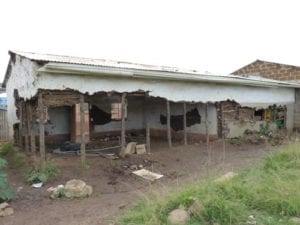A new report is claiming that it could take as long as nine years to eradicate mud schools across the country. Government has dismissed the report, calling it inaccurate and misleading.
Dilapidated public school infrastructure can be found across the country, but the problem is particularly acute in the Eastern Cape where the majority of the so called ‘mud schools’ are located, indicates a report titled ‘Mud to bricks: A review of school infrastructure spending and delivery’, commissioned by the Centre for Child Law. In February 2011 the national Department of Basic Education (DBE) committed to spend R8.2 billion from 1 April 2011 to 1 March 2014 to eradicate mud schools and improve infrastructure of schools throughout South Africa. According to the report, the Provincial Education Departments’ (PED) spending of school infrastructure budgets has generally been good, with the exception of the Eastern Cape and more recently Limpopo. The report says that a big concern is the DBE’s ability to spend the School Infrastructure Backlogs Grant (SIBG), where spending in 2011/12 was a little over 10% and around 41.6% in 2012/13. Delivery by 2023/24? National government has allocated R48 billion to the SIBG and R92 billion to the Education Infrastructure Grant (EIG), to be released over the next number of years subject to the availability of funds and the ability of the education sector to spend the funds. According to the report, a realistic timeframe for the eradication of schools with inappropriate structures, is approximately 2023/24 given current delivery rates. This, it says, could change if pressure is placed on the DBE to structure contracts in such a way as to attract big construction companies to either do the work directly or to manage the sub-contracting. Doing this could bring the end date forward to 2015/16. Government dismisses reportGovernment has dismissed the report as inaccurate, misleading and unhelpful. It says some of the content is outdated and most of the challenges raised in the report have already been addressed.
According to the DBE, the authors of the report did not obtain the latest information on progress made to address school infrastructure from department, relying rather, on disparate sources of data and opinion to produce an adverse finding. “The ASIDI programme has since been beefed up with the appointment of a Programme Manager in October 2011. Since then 70 mud schools have been replaced in the Eastern Cape and 4 in the Western Cape out of the target of the target of 510 schools, including those built entirely from inappropriate material,” the DBE said in a statement. It indicated that a further 100 schools are planned for completion in the Eastern Cape in the course of the next financial year. Nationally, the department will have completed the building of over 200 schools. “To claim the programme will take another nine years when clear progress is being published on an ongoing basis is not only mischievous but unnecessarily pessimistic.” The department also stated that expenditure patterns have improved significantly as a result of improved planning and capacity on the programme, going from R76 million in 2011/12 to R859 million in 2012/13 and to R1.358 billion in 2013/14. It believes this steady increase is an indication of an improving performance. Not without challenges “The programme is not without its challenges,” admits the DBE. “These range from community related issues, work stoppages, poor contractor performance, inclement weather and even gang war fare in some sections of the country. ASIDI is also providing basic services to schools that previously had none.” However, the department claims that more than 200 schools nationally have been given access to water, decent sanitation and electricity for the first time ever.






